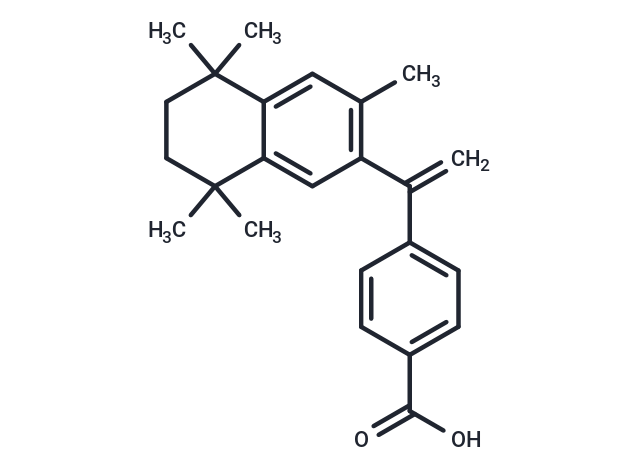Shopping Cart
- Remove All
 Your shopping cart is currently empty
Your shopping cart is currently empty

Bexarotene (LGD1069) is a retinoid analogue that is used to treat the skin manifestations of cutaneous T cell lymphoma (CTCL).

| Pack Size | Price | Availability | Quantity |
|---|---|---|---|
| 10 mg | $30 | In Stock | |
| 25 mg | $44 | In Stock | |
| 50 mg | $62 | In Stock | |
| 100 mg | $91 | In Stock | |
| 200 mg | $123 | In Stock | |
| 500 mg | $261 | In Stock | |
| 1 mL x 10 mM (in DMSO) | $39 | In Stock |
| Description | Bexarotene (LGD1069) is a retinoid analogue that is used to treat the skin manifestations of cutaneous T cell lymphoma (CTCL). |
| In vitro | Bexarotene inhibited the expression of retinoid X receptor alpha and retinoic acid receptor alpha proteins in CTCL cell lines (MJ,HUT78 and 11 h).1 mM and 10 mM Bexarotene treatment of CTCL cell lines (MJ,HUT78 and 11 h) for 96 h increased cellular sub-G1 populations and membrane-bound protein V binding in a dose-dependent manner. Bexarotene treatment reduced the levels of surviving proteins, activated caspase-3 and cleaved poly (ADP-ribose) polymerase, but had no significant effect on the expression of Fas/Fas ligand and bcl-2 proteins in all three CTCL lines.Bexarotene induced a loss of viability and a more pronounced inhibition of clone formation in HH and Hut-78 cells proliferation, while the MJ line showed resistance. |
| In vivo | Bexarotene inhibited the expression of retinoid X receptor alpha and retinoic acid receptor alpha proteins in CTCL cell lines (MJ,HUT78 and 11 h).1 mM and 10 mM Bexarotene treatment of CTCL cell lines (MJ,HUT78 and 11 h) for 96 h increased cellular sub-G1 populations and membrane-bound protein V binding in a dose-dependent manner. Bexarotene treatment reduced the levels of surviving proteins, activated caspase-3 and cleaved poly (ADP-ribose) polymerase, but had no significant effect on the expression of Fas/Fas ligand and bcl-2 proteins in all three CTCL lines.Bexarotene induced a loss of viability and a more pronounced inhibition of clone formation in HH and Hut-78 cells proliferation, while the MJ line showed resistance. |
| Kinase Assay | Biacore studies: Competition assays are performed on a Biacore S51. A Series S Sensor chip CM5 is derivatized for immobilization of a PentaHis antibody for capture of the His-tagged p53. The level of capture is ~ 200 response units (1 response unit corresponds to 1 pg of protein per mm 2). The concentration of MDM2 protein is kept constant at 300 nM. Test compounds are dissolved in DMSO at 10 mM and further diluted to make a concentration series of inhibitor in each MDM2 test sample. The assays are run at 25 °C in running buffer (10 mM Hepes, 0.15 M NaCl, 2% DMSO). MDM2-p53 binding in the presence of inhibitor is calculated as a percentage of binding in the absence of inhibitor and IC50 is calculated using Microsoft Excel |
| Alias | Targretin, Ro 26-4455, LGD1069 |
| Molecular Weight | 348.48 |
| Formula | C24H28O2 |
| Cas No. | 153559-49-0 |
| Smiles | CC1(C)C=2C(C(C)(C)CC1)=CC(C)=C(C(=C)C3=CC=C(C(O)=O)C=C3)C2 |
| Relative Density. | 1.042 g/cm3 |
| Storage | store at low temperature | Powder: -20°C for 3 years | In solvent: -80°C for 1 year | Shipping with blue ice. | |||||||||||||||||||||||||||||||||||
| Solubility Information | DMSO: 20 mg/mL (57.39 mM), Sonication is recommended. Ethanol: 7 mg/mL (20 mM)), Heating is recommended. | |||||||||||||||||||||||||||||||||||
Solution Preparation Table | ||||||||||||||||||||||||||||||||||||
Ethanol/DMSO
DMSO
| ||||||||||||||||||||||||||||||||||||

Copyright © 2015-2025 TargetMol Chemicals Inc. All Rights Reserved.